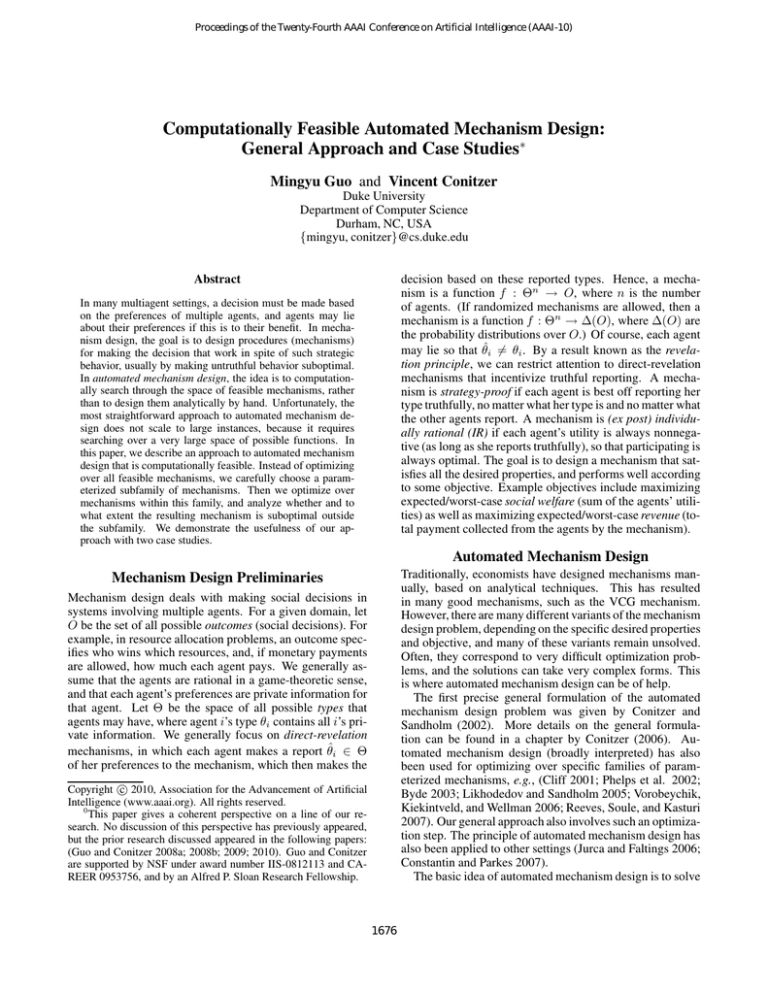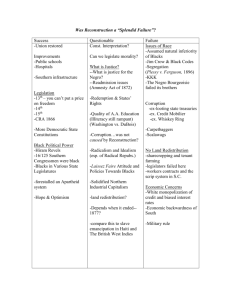
Proceedings of the Twenty-Fourth AAAI Conference on Artificial Intelligence (AAAI-10)
Computationally Feasible Automated Mechanism Design:
General Approach and Case Studies∗
Mingyu Guo and Vincent Conitzer
Duke University
Department of Computer Science
Durham, NC, USA
{mingyu, conitzer}@cs.duke.edu
Abstract
decision based on these reported types. Hence, a mechanism is a function f : Θn → O, where n is the number
of agents. (If randomized mechanisms are allowed, then a
mechanism is a function f : Θn → ∆(O), where ∆(O) are
the probability distributions over O.) Of course, each agent
may lie so that θ̂i 6= θi . By a result known as the revelation principle, we can restrict attention to direct-revelation
mechanisms that incentivize truthful reporting. A mechanism is strategy-proof if each agent is best off reporting her
type truthfully, no matter what her type is and no matter what
the other agents report. A mechanism is (ex post) individually rational (IR) if each agent’s utility is always nonnegative (as long as she reports truthfully), so that participating is
always optimal. The goal is to design a mechanism that satisfies all the desired properties, and performs well according
to some objective. Example objectives include maximizing
expected/worst-case social welfare (sum of the agents’ utilities) as well as maximizing expected/worst-case revenue (total payment collected from the agents by the mechanism).
In many multiagent settings, a decision must be made based
on the preferences of multiple agents, and agents may lie
about their preferences if this is to their benefit. In mechanism design, the goal is to design procedures (mechanisms)
for making the decision that work in spite of such strategic
behavior, usually by making untruthful behavior suboptimal.
In automated mechanism design, the idea is to computationally search through the space of feasible mechanisms, rather
than to design them analytically by hand. Unfortunately, the
most straightforward approach to automated mechanism design does not scale to large instances, because it requires
searching over a very large space of possible functions. In
this paper, we describe an approach to automated mechanism
design that is computationally feasible. Instead of optimizing
over all feasible mechanisms, we carefully choose a parameterized subfamily of mechanisms. Then we optimize over
mechanisms within this family, and analyze whether and to
what extent the resulting mechanism is suboptimal outside
the subfamily. We demonstrate the usefulness of our approach with two case studies.
Automated Mechanism Design
Traditionally, economists have designed mechanisms manually, based on analytical techniques. This has resulted
in many good mechanisms, such as the VCG mechanism.
However, there are many different variants of the mechanism
design problem, depending on the specific desired properties
and objective, and many of these variants remain unsolved.
Often, they correspond to very difficult optimization problems, and the solutions can take very complex forms. This
is where automated mechanism design can be of help.
The first precise general formulation of the automated
mechanism design problem was given by Conitzer and
Sandholm (2002). More details on the general formulation can be found in a chapter by Conitzer (2006). Automated mechanism design (broadly interpreted) has also
been used for optimizing over specific families of parameterized mechanisms, e.g., (Cliff 2001; Phelps et al. 2002;
Byde 2003; Likhodedov and Sandholm 2005; Vorobeychik,
Kiekintveld, and Wellman 2006; Reeves, Soule, and Kasturi
2007). Our general approach also involves such an optimization step. The principle of automated mechanism design has
also been applied to other settings (Jurca and Faltings 2006;
Constantin and Parkes 2007).
The basic idea of automated mechanism design is to solve
Mechanism Design Preliminaries
Mechanism design deals with making social decisions in
systems involving multiple agents. For a given domain, let
O be the set of all possible outcomes (social decisions). For
example, in resource allocation problems, an outcome specifies who wins which resources, and, if monetary payments
are allowed, how much each agent pays. We generally assume that the agents are rational in a game-theoretic sense,
and that each agent’s preferences are private information for
that agent. Let Θ be the space of all possible types that
agents may have, where agent i’s type θi contains all i’s private information. We generally focus on direct-revelation
mechanisms, in which each agent makes a report θ̂i ∈ Θ
of her preferences to the mechanism, which then makes the
c 2010, Association for the Advancement of Artificial
Copyright Intelligence (www.aaai.org). All rights reserved.
0
This paper gives a coherent perspective on a line of our research. No discussion of this perspective has previously appeared,
but the prior research discussed appeared in the following papers:
(Guo and Conitzer 2008a; 2008b; 2009; 2010). Guo and Conitzer
are supported by NSF under award number IIS-0812113 and CAREER 0953756, and by an Alfred P. Sloan Research Fellowship.
1676
for the function f as a constrained optimization problem,
where the desired properties (e.g., strategy-proofness, IR)
correspond to the constraints in the optimization, and the
objective (e.g., social welfare, revenue) corresponds to the
objective in the optimization.
To illustrate the framework, suppose that we have a prior
distribution p for the true type vector of the agents, p :
Θn → [0, 1]. Let ui (θ, o) be the utility that agent i obtains if she has true type θ and the outcome is o. Finally,
suppose (for the sake of example) that strategy-proofness is
the only desired property (no IR), we want the mechanism
to be deterministic, and we aim to maximize expected social
welfare. We obtain the following general formulation:
Unlike in the more basic automated mechanism design
approach described earlier, this approach requires significant
human input: we need to find a good subfamily Ω′ as well as
a formulation/algorithm for optimizing over this subfamily,
and in the end we need to analyze the suboptimality of the
resulting mechanism by hand. From the perspective of artificial intelligence, it may be disappointing that the approach
requires so much domain-specific expertise from humans.
On the other hand, we have been much more successful at
contributing new results to microeconomic theory with this
human-machine interactive approach, so we believe that at
this point, this is the best way in which artificial intelligence
can make contributions to the theory of mechanism design.
The key step is choosing Ω′ . If Ω′ is too restrictive, then
even if we find the optimal mechanism in it, its performance
will be too suboptimal. If Ω′ is too general, then the optimization problem becomes too difficult again. That is, we
want Ω′ to be general enough that an (almost) optimal mechanism exists in Ω′ , and Ω′ to be specific enough that we
know how to optimize over its parameters. Of course, choosing a good Ω′ is not as simple as doing a binary search on the
specificity-generality spectrum: an unfortunate choice may
result in an Ω′ that is difficult to optimize over and still does
not produce good mechanisms! The point is that there is
some “art” involved in choosing a good Ω′ .
In the remainder of this paper, we present two case studies corresponding to our previous work. The first studies resource allocation mechanisms that redistribute their revenue
to the agents. Here, we found a good Ω′ with a bottom-up
approach, by finding a natural generalization of some good
example mechanisms. The second studies resource allocation mechanisms that do not require payments at all. Here,
we found a good Ω′ with a top-down approach, by increasingly restricting the family of mechanisms until we found
one that is easy to optimize over. In both cases, we obtained
mechanisms that are optimal or nearly optimal even in the
general family Ω.
Variable function: f : Θn → O
Maximize
P
~ Pn ui (θi , f (~
θ)) (expected social welfare)
~
i=1
θ∈Θn p(θ)
Subject to:
(∀i ∈ {1, 2, . . . , n}, ~
θ ∈ Θn , θi′ ∈ Θ)
ui (θi , f (~θ)) ≥ ui (θi , f ((θ1 , . . . , θi−1 , θi′ , θi+1 , . . . , θn ))
(strategy-proofness)
A key problem is that this is a problem of optimizing a
function. The most basic approach to solving such problems is as follows (Conitzer and Sandholm 2002). If the type
space Θ and the outcome space O are finite, and we allow
for randomized mechanisms, then it is possible to write this
as a linear program: this is done by defining a probability
variable pf (o|~θ) for each θ~ ∈ Θn and o ∈ O. For the case
where we require a deterministic mechanism, we can add the
constraint that each of these probabilities must be in {0, 1}
to obtain an integer program (in the deterministic case, the
problem is generally NP-hard even with one agent). Still,
the scalability of this approach is very limited. One reason
is that both the number of variables and the number of constraints are exponential in n. Another problem is that type
spaces are generally not finite and require discretization for
this approach to work. For small instances, this approach
is feasible, and the solutions to these small instances will
sometimes allow us to conjecture more general results, but
generally the limitations on scalability are too constraining.
Case Study 1: Redistributing Vickrey Revenue
Problem description. We study the problem of allocating
one item among n agents. An example single-item allocation scenario would be a multi-user computer system in
which a group of users need to decide who gets to use a
certain system resource at a certain time. (Our full research
papers study more general allocation problems; we focus on
single-item allocation here for the purpose of presentation.)
Each agent i has a true valuation vi for the item; if she wins
at a price of πi , her utility is vi − πi (quasilinear utilities).
Without loss of generality, assume v1 ≥ v2 ≥ . . . ≥ vn .
The standard strategy-proof mechanism for this is the
Vickrey auction: the highest bidder (bidder 1) wins and pays
the second-highest bid, v2 . (Because we are interested in
strategy-proof mechanisms, here we do not distinguish between true and reported preferences.) While this is a natural
mechanism if there is a seller who can collect the revenue
v2 , this is not always the case. For example, the agents may
be trying to allocate a jointly owned resource—for instance,
who gets to use our jointly owned machine on the day of the
High-Level Description of Our Approach
Our general approach to addressing the scalability issue can
be described as follows.
• For a specific setting, let Ω denote the set of all feasible
mechanisms.
• Instead of optimizing over Ω directly, we first choose a
suitable subfamily Ω′ ⊆ Ω based on analytical considerations, where the mechanisms in Ω′ can be parameterized
using k parameters, so that a vector (c1 , . . . , ck ) defines a
mechanism fc1 ,c2 ,...,ck ∈ Ω′ .
• We then optimize over (c1 , . . . , ck ), which is generally a
much easier problem.
• Finally, we analytically study the suboptimality of the resulting mechanism in the full set Ω.
1677
deadline? In this case, it makes sense for the auction’s revenue to be redistributed to the agents, rather than to simply
throw it away. Unfortunately, doing so naı̈vely will break the
strategy-proofness property: the second-highest bidder will
want to make the highest bidder pay more, if the former receives a fraction of this payment. In fact, it is not possible to
redistribute all the revenue and maintain strategy-proofness.
However, it is possible to redistribute a large fraction of the
revenue, as the next two examples show.
Two example redistribution mechanisms. The first
example redistribution mechanism is called the BaileyCavallo mechanism, which was proposed independently
(from slightly different perspectives) in at least three papers (Bailey 1997; Porter, Shoham, and Tennenholtz 2004;
Cavallo 2006). The idea is as follows. Giving each agent
an equal share v2 /n of the revenue does not work because
it introduces an incentive for the second-highest bidder to
make the highest bidder pay more. Instead, under the BC
mechanism, each agent i receives v2−i /n, where v2−i is the
second-highest bid among bids other than i’s bid. (Hence,
v2−i = v3 for i ∈ {1, 2}, and v2−i = v2 for i ∈ {3, . . . , n}.)
Because it is impossible for an agent to affect her own redistribution with her bid, the incentives are the same as in
the Vickrey auction, hence the mechanism is strategy-proof.
The total amount redistributed is 2v3 /n+(n−2)v2 /n, which
is never more than the Vickrey revenue v2 (so the redistribution scheme is feasible), and it is at least (n − 2)/n of the
Vickrey revenue.
While this is a very natural mechanism, we found (by
hand) a different mechanism that also redistributes a large
amount of revenue, based on a similar idea. Under this
v2−i
−
mechanism, the amount redistributed to bidder i is n−2
Conitzer 2009). This linear program gives us the optimal
solution for any given n. This allowed us to obtain the
optimal solution for specific values of n using a standard
linear program solver. By inspection of these values, we
were able to generalize these solutions to the case of general
n, to obtain the following mechanism: c0 = c1 = 0 and
ci =
(−1)i (n−1)
i
Pn−1
j=1
(
Pn−1
n−1
j
j=i
n−1
n−1
j
i
)(
(
)
)
for i = 2, . . . , n − 1.
The corresponding worst-case fraction of Vickrey
revenue
Pn−1 n−1
redistributed equals 1 − n−1
/
.
j=1
1
j
Not only does this mechanism perform better than the existing mechanisms in the worst case, but (from simulations)
it actually turns out that in many cases it also performs better
on average.
The final step is to analyze how suboptimal this mechanism is in the family of all feasible mechanisms. In this case,
it turns out that this mechanism is actually optimal among
all mechanisms—the proof is in (Guo and Conitzer 2009).
It should be noted that this mechanism is not uniquely optimal. Guo and Conitzer (2008c) and Apt et al. (2008) show
that there are mechanisms outside of the linear family that
redistribute at least as much in every case, and strictly more
in some cases—though, of course, they redistribute the same
amount in the worst case.
The mechanism described above was independently derived by Moulin (2009), as the solution to a slightly different
optimization problem. (The solution in our paper (Guo and
Conitzer 2009) is for a somewhat larger class of settings.)
We used similar techniques to find mechanisms that maximize expected redistribution, when a prior distribution is
available (Guo and Conitzer 2008b). Another insight is that
we can sometimes decrease the loss from failing to redistribute by not allocating the items to the agents who value
them most, with the net effect being an increase in welfare (Guo and Conitzer 2008a; de Clippel, Naroditskiy, and
Greenwald 2009).
2v3−i
(n−2)(n−3)
(where v3−i is the third-highest bid among bids
other than i’s). The total amount redistributed by this mech6v4
anism is v2 − (n−2)(n−3)
, which is never more than the
6
of the
Vickrey revenue v2 and at least 1 − (n−2)(n−3)
Vickrey revenue (we require that n is large enough that
6
1 − (n−2)(n−3)
≥ 0).
Which of the two redistribution mechanisms is better?
Each redistributes more than the other in some cases. However, if n is large enough, the second mechanism redistributes a larger fraction of the Vickrey revenue in the worst
case. This immediately leads to the question of whether
there are even better redistribution mechanisms, for example, using v4−i .
Linear redistribution mechanisms. This also gives us a
very natural subfamily Ω′ of mechanisms to optimize over,
namely, the mechanisms where the redistribution to agent i
−i
is c0 + c1 v1−i + c2 v2−i + . . . + cn−1 vn−1
for some vector
of constants (c0 , . . . , cn−1 ). We call this the family of linear redistribution mechanisms, and each of its members is
uniquely identified by its vector (c0 , . . . , cn−1 ), giving us a
natural parameterization.
Results. To optimize for the worst-case redistribution
fraction, it is possible to set up a linear program for finding
the best values for the ci . A few tricks are required to set
up this linear program; the details can be found in (Guo and
Case Study 2: Strategy-proof Allocation
without Payments
Problem Description. We now study the problem of allocating m items between two agents, in settings where monetary payments are not feasible (e.g., when we are dealing
with software agents, or in other settings in which there
is no established currency, such as in a peer-to-peer network). We allow for randomized mechanisms (equivalently,
we can consider divisible items). We assume that the agents
have additive utility functions, so that an agent whoP
receives
item j with probability aj obtains a total utility of j aj vj ,
where vj is her utility for item j. We can also think of aj
as the proportion of item j that the agent receives. In order
to be able
P to compare agents’ utilities to each other, we assume j vj = 1 for every agent (when an agent wins all the
items, she is 100% satisfied).
Given two mechanisms, if for all possible type vectors,
the social welfare under mechanism one is at least α times
1678
the social welfare under mechanism two, then we say mechanism one is α-competitive against mechanism two, where
α is called the competitive ratio, and the maximal possible
competitive ratio is called the maximal competitive ratio.
Our goal is to design a strategy-proof mechanism that has
high competitive ratio against the first-best allocation mechanism (the mechanism that always successfully picks the allocation that maximizes the social welfare—of course, the
first-best allocation mechanism is not strategy-proof itself).
Linear increasing-price (LIP) family. We do not have
a useful characterization of all strategy-proof mechanisms,
nor do we know how to evaluate the maximal competitive
ratio of an arbitrary strategy-proof mechanism (against the
first-best allocation mechanism). We performed a sequence
of restrictions on the family of mechanisms, starting with
all strategy-proof mechanisms and eventually reaching the
family of linear increasing-price (LIP) mechanisms (due to
space constraint, we omit description of the intermediate
families). Any LIP mechanism is characterized by a single
parameter c (c > 0). LIP (c) is defined as follows.
LIP(c) : We flip a coin that determines which agent becomes the dictator. The dictator is endowed with 1 unit of
artificial currency, which can be used to purchase items. At
any moment, the instantaneous price charged to the dictator
for buying another infinitesimal part of item j is cxj + ecc−1 ,
where xj is the amount of artificial currency the dictator
has already spent on j at that moment. That is, if the dictator spends x of her artificial currency
R x on item j, then she
receives that item with probability 0 1/(ct+ ecc−1 )dt. After
the dictator exhausts her artificial currency, the other agent
gets what is remaining.
Results. For at least two items, for any c > 0, we proposed a technique that computes the maximal competitive
ratio of LIP (c). (To be more precise, the technique computes a close lower bound on the maximal competitive ratio
of LIP (c).) Since the LIP family is characterized by only
one parameter, we simply searched for the values of c that
correspond to high competitive ratios. For the case of two
items, we found that LIP (2)’s maximal competitive ratio
is (at least) 0.828, which is very close to an upper bound
of 0.841 that we derive for any strategy-proof mechanism.
That is, for the case of two items, it is without much loss of
optimality to focus on the LIP family. However, as the number of items increases, the competitive ratios become worse.
That is, for large numbers of items, we may want to consider
other families of mechanisms.
it would be desirable to find ways to reduce the burden that
is placed on the human designer.
References
Apt, K.; Conitzer, V.; Guo, M.; and Markakis, E. 2008. Welfare
undominated Groves mechanisms. In WINE, 426–437.
Bailey, M. J. 1997. The demand revealing process: to distribute
the surplus. Public Choice 91:107–126.
Byde, A. 2003. Applying evolutionary game theory to auction
mechanism design. In EC, 192–193.
Cavallo, R. 2006. Optimal decision-making with minimal waste:
Strategyproof redistribution of VCG payments. In AAMAS, 882–
889.
Cliff, D. 2001. Evolution of market mechanism through a continuous space of auction-types. Technical Report HPL-2001-326, HP
Labs.
Conitzer, V., and Sandholm, T. 2002. Complexity of mechanism
design. In UAI, 103–110.
Conitzer, V. 2006. Computational aspects of preference aggregation. Ph.D. Dissertation, Carnegie Mellon University. Available as
technical report CMU-CS-06-145.
Constantin, F., and Parkes, D. 2007. On revenue-optimal dynamic
auctions for bidders with interdependent values. In AMEC, 1–15.
de Clippel, G.; Naroditskiy, V.; and Greenwald, A. 2009. Destroy
to save. In EC, 207–214.
Guo, M., and Conitzer, V. 2008a. Better redistribution with inefficient allocation in multi-unit auctions with unit demand. In EC,
210–219.
Guo, M., and Conitzer, V. 2008b. Optimal-in-expectation redistribution mechanisms. In AAMAS, 1047–1054. Journal version to
appear in AIJ.
Guo, M., and Conitzer, V. 2008c. Undominated VCG redistribution
mechanisms. In AAMAS, 1039–1046.
Guo, M., and Conitzer, V. 2009. Worst-case optimal redistribution
of VCG payments in multi-unit auctions. Games and Economic
Behavior 67(1):69–98.
Guo, M., and Conitzer, V. 2010. Strategy-proof allocation of multiple items between two agents without payments or priors. To
appear in AAMAS.
Jurca, R., and Faltings, B. 2006. Minimum payments that reward
honest reputation feedback. In EC, 190–199.
Likhodedov, A., and Sandholm, T. 2005. Approximating revenuemaximizing combinatorial auctions. In AAAI, 267–273.
Moulin, H. 2009. Almost budget-balanced VCG mechanisms to
assign multiple objects. Journal of Economic Theory 144(1):96–
119.
Phelps, S.; McBurnley, P.; Parsons, S.; and Sklar, E. 2002. Coevolutionary auction mechanism design. Lecture Notes in AI 2531.
Porter, R.; Shoham, Y.; and Tennenholtz, M. 2004. Fair imposition.
Journal of Economic Theory 118:209–228.
Reeves, D. M.; Soule, B. M.; and Kasturi, T. 2007. Yootopia!
SIGecom Exchanges 6(2):1–26.
Vorobeychik, Y.; Kiekintveld, C.; and Wellman, M. 2006. Empirical mechanism design: Methods, with application to a supply
chain scenario. In EC, 306–315.
Conclusion
We believe that the approach to automated mechanism design that we have described in this paper, where the analytical capabilities of a human mechanism designer work in
concert with algorithms that search through restricted families of possible mechanisms, is currently the most promising avenue for techniques from artificial intelligence to contribute to the theory of mechanism design and (perhaps) microeconomic theory in general. The human mechanism designer plays an essential role at several points in this process. For future research on automated mechanism design,
1679




